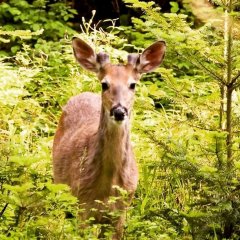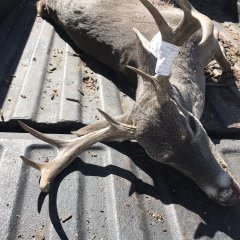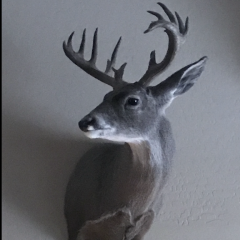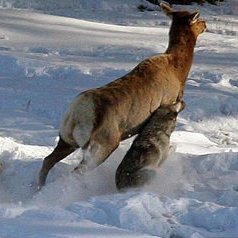-
Content Count
18 -
Joined
-
Last visited
About washingtondc
-
Rank
Member
- Birthday 10/15/1973
Profile Information
-
Gender
Male
-
Interests
Wildlife Art, Photography, Painting and Drawing, Music, Travel, Languages, Food and Culture
Recent Profile Visitors
2,164 profile views
-

Coues Paintings......
washingtondc replied to coueshunter's topic in Miscellaneous Items related to Coues Deer
The Mike Fabritz link is no longer there. I would like to get a Klondyke Butte print if it is available. It was the painting with mountain backdrop with Course deer bounding. I am in the area until Wednesday. -
I disagree with this map for Southern California label of desert mule deer. The deer in the Traverse Ranges north of Los Angeles are California mule deer. The Deer of the mountains and hills south of San Gabriel and Pomona Valleys are Southern mule deer (Baja mule deer). It is possible historically that the deer of Los Angeles area were a hybrid between California mule deer and Southern mule deer. Not desert mule deer. Also Southern part of Baja may be a different subspecies of mule deer. I also think inland San Bernardino, Riverside, and Imperial Counties have lowland desert areas where mule deer are absent until the Arizona border.
-
My latest - Coues deer in Madera Canyon (watercolor)
-
My latest watercolor of Coues Whitetail deer in Madera Canyon.
-

Best white-tailed deer plush toy and American elk plush toy available
washingtondc posted a topic in Miscellaneous Items related to Coues Deer
This is the best white-tailed deer plush toy out on market for any white-tailed deer enthusiast is available at http://www.stuffedsafari.com. The best American elk plush toy (also bugles) is available at http://www.sportsmans.com. All I can say is, it's about time! -
There is something fascinating with white-tailed deer of the West and how they find their niche amongst several large herbivores. They are my favorite North American deer. I enjoyed viewing the Northwest white-tailed deer in Idaho Panhandle (in my profile) and Texas white-tailed deer in the Hill Country (decades ago). I look forward to see the Coues deer in AZ or NM. If I do New Mexico I would like to visit Fort Bayard (Coues deer) and Cloudcroft (Texas white-tailed deer) in the Sacramento Mountains. The other would be the Columbian white-tailed deer in Roseburg, OR. These past few years have been a first for me dabbing into photography while combining sketching and painting.
-
The top is my first drawing/watercolor of Coues white-tailed deer. Inspiration came from a photograph I have seen here on this forum, plus a famous Arizona White-tailed deer painting by Louis Agassiz Fuertes seen in Wild Animals of North America. The bottom is a larger scaled version using oil paints. The drawing is slightly different. I am wondering if acrylics is easier.
-
 washingtondc changed their profile photo
washingtondc changed their profile photo
-
On the contrary, white-tailed deer do live in Guyana.
-

While we are on the subject (Mexican Coues)
washingtondc replied to desertdog's topic in Coues Biology
Wow, those are great shots! So...the deer is called Coues' Deer (is this the correct way?) I just wish more books on white-tailed deer would show side-by-side pictures and perhaps discuss these "observations". As a lay reader and non-biology reader, I confess that some of the readings are tough for me to understand. Sometimes I am not even sure if they get to the point either. The "thesis" I saw on separating northern and southern whitetailed deer was a research paper (pdf file) that seemed to be done by a student/researcher at a university in one of the Central American countries. The paper was both in English and Spanish. I don't seem to find it on the internet anymore...or at least I haven't been researching "hard enough" for it. The reading that discussed possibly several "subspecies" of white-tailed deer, last I remember, was really based on records and observations from past...early settlers maybe? You're right, such information really is not reliable as it is really hard to prove...and it was not written as factual...but more as a documentation. These observations were from lay people or perhaps people of science who lacked the methodologies of today. I am always on the lookout for the latest on white-tailed deer genetics...but as an animal artist...the photographs and pictures attract me more to the book. Some books that are good are "Whitetails in Action" and "Amazing Whitetails" by Mike Biggs...he has some great Texas white-tailed deer photographs. I have these two books at home too. The Whitehead Encyclopedia of Deer, I purchased in Seattle...it is a rare book that I paid good money for, but was well worth it. BTW, I have a compendium of red deer from Dr. Geist that separates this animal into 3 species (European Red Deer, Central Asian Red Deer, Asian and American Wapitis). Like I said earlier...I tend to side with Dr. Geist on his red deer and mule deer research. But, he doesn't write much on white-tailed deer. washingtondc -

While we are on the subject (Mexican Coues)
washingtondc replied to desertdog's topic in Coues Biology
Unless whitetails were brought to that part of South America...it must be another species. White-tailed deer are in the northern part of South America. -

While we are on the subject (Mexican Coues)
washingtondc replied to desertdog's topic in Coues Biology
Bill, Thank you for clarifying your experience in viewing pictures of white-tailed deer. I respect works from Dr. Geist and I do have the Whitehead's Encyclopedia of Deer. So you say that my belief does not hold water? Well, perhaps...I confess that I haven't seen a lot of pictures of these animals as you have...so yes, you have more experience than me. I have seen several books on white-tailed deer...and it would be great if there were books with photographs showing such regional variations of deer in the SE United States. However, I am interested in knowing what distinguishes these different deer, and have had a tough time finding good photos that show clear distinctions. The white-tailed deer is a cool animal, and I would love to see some of the photos that you have seen. I just wish a lot of this stuff would be made available. I did read Dr. Geist's work, and I think he is good with red deer and wapiti. I do like his stuff on mule deer too. The white-tailed deer, however, I don't know what other sources are available. But, I would love to see what you have seen. I know that some northern white-tailed deer have dark black on the their muzzle that goes near the eyes...but I don't know if this is distinctly a northern white-tailed deer thing. cheers, washingtondc -
That's what I am guessing..... Of course the genetic analysis might change all that! Amanda Ever since reading Dr. Geist's publications...it would be interesting if white-tailed deer genetics and mtDNA were revisited, the question is feasibility. The constraint with Central and South American white-tailed deer is that many populations are already threatened or extinct...due to hunting practices and politics in those regions. It doesn't seem to be feasible...perhaps in Mexico this is a possibility(?). I think Costa Rica...it would be feasible...Venezuela...I am not sure either, there was some political instability...and I am not sure about Venezuela's relations with USA. White-tailed deer are very popular game animals...and I think that collectively, we, as Americans, may take them for granted. I think the white-tailed deer subspecies of the Northwestern and Southwestern United States are distinct. I think the Key deer is also distinct. What is ambiguous are the deer populations in the East Coast with the restocking histories. It seems like the Southern white-tailed deer (Odocoileus virginianus virginianus) may be a mix of several deer from Texas, Midwest, and Great Lakes...I think the Kansas white-tailed deer may be mixed between Texas, Northern, and Southern deer. I am not even sure what clearly distinguishes Dakota, Northern, Kansas, or Virginian white-tailed deer other than possibly the size. I have looked at several Outdoor Life magazines...and these deer look the same to me! I draw these animals...and still can't tell what is distinctive. I know that Texas white-tailed deer are distinctive...Coue's deer with their large ears are distinctive. Northwest white-tailed deer are more yellowish...and distinctive in that way... I even read somewhere that there were once several subspecies in the Southwest, but due to hunting...the Texas, Coue's, and Carmen Mountains deer are the surviving subspecies...while the rest either were hunted to extinction or absorbed/assimilated into the Texas white-tailed deer? Heck, you'd think that with our country and most populous East Coast/Southern States...we should easily find out these things? There is ambiguity in the indigenous wolf population in East coast too! There are wolves in Algonquin Provincial Park...and now scientists don't think that there are really Eastern Timber wolves...and instead, Red Wolves? red wolf/gray wolf hybrids?, coyote/wolf/red wolf hybrids?...They can't make up their minds on this...
-

While we are on the subject (Mexican Coues)
washingtondc replied to desertdog's topic in Coues Biology
I just got this book too...and it came in the mail yesterday! -

While we are on the subject (Mexican Coues)
washingtondc replied to desertdog's topic in Coues Biology
I am not a biology major...and yes, I am an outdoor nut...I draw a lot of these animals and like reading on them. I started by drawing a lot of these animals...then it turned into a hobby where I was actually reading about these animals and learning of their distinguishing features to try and draw them more precisely. I think the best books are "Deer of the World" by Dr. Valerius Geist, and "White-Tailed Deer: Ecology and Management" by Lowell K. Hall (Editor). I've been meaning to ask Dr. Geist if the scientific community is separating the North and South American white-tailed deer into two species...I have seen a thesis on this somewhere on the internet. There is something fascinating with the open plains/savanna adapted animals. I am also looking into information on the Spanish Red Deer that lives in the Chaparral Habitats of Southern Spain. -

While we are on the subject (Mexican Coues)
washingtondc replied to desertdog's topic in Coues Biology
Coue's White-Tailed Deer have the largest range in Mexico and live along the Sierra Madre Occidental that extends from the Chiricahua Mountains of SE Arizona and SW New Mexico. The deer that straddle US/Mexico border belong to one of the three subspecies: Coue's White-Tailed Deer (O. v. couesi) Carmen's Mountain White-Tailed Deer (O. v. carminis) Texas White-Tailed Deer (O. v. texanus) These are open woodland/savanna adapted deer that have relatively large/complex antlers and long tails in proportion to body size. There is probably much genetic variation...as is typical of any white-tailed deer population. There are several subspecies identified in Latin America (Mexico, Central America, and South America)...but I think with the latest technology and practices in scientific classification...this subspecies list many need to be revisited. White-Tailed Deer in Eastern USA are largely mixed in the Southern States due to restocking of deer from as far west as Texas and Great Lakes regions)... The problem with the research needed is that many populations of white-tailed deer in Central and South America are shrinking, have disappeared, or vulnerable...due to uncontrolled hunting and human population pressures. As usual...politics... Incidentally, I have seen far too many white-tailed deer books that make the mistake of showing the habitat distribution of white-tailed deer to live in Arizona and Mexico as far west as the Colorado River that borders AZ/CA, or they show white-tailed deer living east of the Sierra Nevada Mountains bordering CA/NV. There is inconclusive evidence for this. Also, white-tailed deer are largely absent from the Columbia basin of Eastern Washington and Oregon. In the Great Plains, they live along river valley bottomlands and adjacent agricultural croplands where they inhabit corn patches. There might have been a continuous population that linked the Northwest White-Tailed Deer (NE WA, ID, MT, SE BC) with the Columbia White-Tailed Deer...but that would have been populations along the Columbia River from British Columbia to the Pacific Ocean. The white-tailed deer has largely disappeared from much of the Columbia River in Eastern Washington. Today white-tailed deer are found largely in Idaho, in Washington along the Idaho Border, and Oregon's Blue Mountains. I believe the Columbian white-tailed deer once lived in the Cowlitz River (WA) and Willamette River (OR) valleys...because there is much bottomland mixed forest. I believe that white-tailed deer may potentially extend their range into NE Utah... I have an Audobon handbook of Southwestern Wildlife, but it says white-tailed deer live in N Utah and W Nevada...because it was based on the big old map that is largely inaccurate and placed in way too many books and encyclopedia articles on white-tailed deer. The best book on White-Tailed Deer is White-Tailed Deer: Ecology and Management, by Lowell K. Hall (Editor), and Deer of the World: Their Evolution, Behaviour, and Ecology, by Valerius Geist These two books have the best information so far, on white-tailed deer







